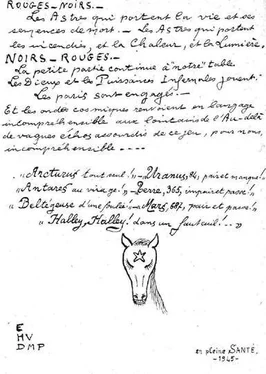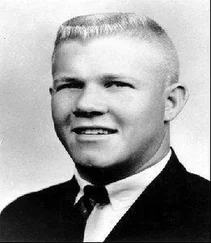Président Leser agreed to open the suitcase to see if Adrien’s jackets had in fact been ripped or altered in any way. As the clerk of the court, Wilmès, tried to remove the suitcase, the towering stack of evidence started to sway. Leser called for an immediate recess. Wilmès later admitted that he had feared that the suitcases might fall on him.
Petiot suggested that the guards remain in the room to prevent any theft. Turning to Floriot, he joked that if the court did in fact find a million francs, would he receive ten percent?
WHEN the court reconvened, the clerk opened seal number 54, a yellow suitcase with black leather corners that contained the clothes and personal belongings of Adrien the Basque. A musty odor escaped the old suitcase, as the usher rummaged through its contents looking for the gangster’s suit. When he found the jacket in question, Petiot snatched it and displayed it for the court, triumphantly pointing out that the garment was intact. Petiot grabbed another one. “Same thing,” he said, “not unsealed, very sure of that.”
Once again, instead of trying to poke holes in the defense, Dupin retreated, this time moving on to what should have been more solid ground. “The Wolffs were Jews who fled the German repression. They were one hundred percent Resistants.”
“They were Germans,” Petiot said. “They came from Berlin.”
“That’s false,” the Wolff family lawyer, Maître Jacques Bernays, interjected. “The Wolffs left Holland on June 12, 1942, and I have obtained a number of witnesses that prove that they lived in fear of reprisals from the Gestapo.”
Floriot countered with a police report written by Inspector Battut that documented the Wolffs’ arrival in France with a passport issued in Berlin identifying them as “refugees.” Jews who feared for their lives because of state-sanctioned terror, Floriot added, rarely applied to that government for a passport. In Paris, they “hid in a hotel requisitioned by the Germans.”
“They hid themselves the way I did when I was newly married,” Petiot said. “I pulled the sheets over my head and said to my wife, ‘Try to find me.’ ”
In the ensuing laughter, Dupin neglected to call out Floriot for omitting one important fact: The Wolffs’ passport was not issued in 1942, as it appeared in the discussion, but nine years before.
Petiot admitted to killing the Wolffs, as well as the Jewish couple that followed them, Gilbert and Marie-Anne Basch. They were a similar case, Petiot said, and therefore received the same fate.
“What about the Schonkers, the parents of [Marie-Anne] Basch?”
Petiot mocked the prosecutor. “I don’t know anything about them, but if it makes you happy, you can put them on my account. They came from the same bunch, and if I had met them I would have killed them.”
All of these Jewish families, Petiot added, had been sent to him by Eryane Kahan, whom the defense would present as a German agent trying to infiltrate Petiot’s Resistance organization.
“Why didn’t you kill Eryane Kahan, then, if you knew she was collaborating with the Germans?”
Petiot wanted her to send him more traitors. “If Kahan had sent me a hundred, like the Wolffs and the Baschs, I would have killed all one hundred. Then, Kahan would have been the hundred-and-first.”
The press, now keeping score of the trial like a soccer match, generally handed the victory to Petiot. The prosecution was failing even to establish that Jews fleeing Nazi persecution were not Gestapo agents. Petiot had had a good day indeed. After three days, he was winning by most accounts two to one.
At the end of the session, when two elegant women left the courtroom, one turned to the other and said that she had “never been more amused.” Overhearing the comment, a thin man in a shabby suit shouted at the women and attacked. He was, it was later learned, an Auschwitz survivor who had lost almost his entire family in Nazi death camps.
29.
INSIDE MURDER HOUSE
I AM ONE OF THOSE VICIOUS PEOPLE WHOM WORK AMUSES.
—Marcel Petiot
ON Thursday, March 21, 1946, the first official day of spring, the trial continued with the wrap-up of the président’s interrogatoire and ended with the calling of the first witnesses. There were as usual many heated debates and lengthy digressions, including Petiot’s story of a Nazi attempt to capture a Resistant, who had parachuted into the farmlands outside Lyon, by mobilizing a force of “four hundred prostitutes.” Leser repeatedly interrupted, insisting that Petiot stay on subject.
Very little new information emerged this day. Petiot at one point said that he had handed over Yvan Dreyfus to his so-called chief, Robert Martinetti, near the Place de la Concorde and watched the two men walk away in the direction of the Naval Ministry. This statement contradicted his previous account, namely that he left Dreyfus with his comrades at rue Le Sueur, but the prosecution again failed to force him to explain the discrepancy.
Petiot was instead allowed to tell the court how he had stood up to his Gestapo interrogators in prison. When they questioned him about Dreyfus, for instance, Petiot boasted of his answer: “If he’s a Jew, what difference does it make to you that he disappeared? If he’s an informer, you’ll soon find another. I was risking my neck, Monsieur le Président, but I was having a lot of fun.”
When Leser asked about Petiot’s brother’s concern for the fate of Yvan Dreyfus, Petiot admitted that Maurice had been a client and friend of the Dreyfus family, and he had tried to convince Yvan’s father to intervene on his behalf. This was not followed to any significant conclusion, and the jury never heard Nézondet’s allegation that Maurice claimed to have seen Dreyfus’s body in June 1943 on top of the pile of cadavers at his brother’s basement.
Before the jury had time to appreciate the tragedy of this disappearance, Floriot declared for the court that a Gestapo file from 1943 confirmed that Dreyfus had served as “an informer of the Gestapo.” As a result, Floriot said, “there is no need to feel sorry over the fate of Yvan Dreyfus.”
Président Leser, the advocate-general Dupin, and the Dreyfus family attorney, Maître Véron, all objected to this statement. Véron questioned the accuracy of the file, reminding the court of Dreyfus’s patriotic record: how he had returned to France in 1939 to fight the Germans, only to be arrested when he tried to escape to England and join de Gaulle.
“Dreyfus was a traitor four times over: a traitor to his race, a traitor to his religion, a traitor to his country, and a traitor …,” Petiot began, before Leser, Véron, and Dupin all again protested loudly. The correspondent for the Sydney Morning Herald described the scene in the courtroom: “Petiot ranted, roared, stamped his feet and waved his fists to the accompaniment of quarrels among counsel as fights broke out in the public gallery.”
As tensions remained high, Leser turned to the Kneller case, the last discovery before the investigation officially closed in the fall of 1945. Would Petiot really claim that Kneller, a veteran of the French Foreign Legion, was a collaborator? Was his seven-year-old son, René, also a collaborator?
Kurt Kneller was his patient, Petiot said, adopting his usual tactic of pointing out that “professional secrecy” precluded him from revealing the nature of his ailment. This argument was wearing thin, and as for his professional secrecy, that had not stopped him in other instances.
Petiot then boasted of how much he had allegedly helped the Kneller family. He had secured them false identities, one Alsatian, the other Belgian, and advised them to carry two bottles of cognac to give the guides who would escort them across the border. He had even loaned the family money to buy railway tickets to Orléans for the first part of the journey. Given these services, and the fact that the Knellers still owed him 2,000 francs for previous medical treatment, Petiot had asked the family to leave their furniture with him as collateral.
Читать дальше












